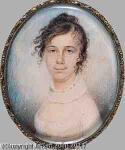Anna Claypoole Peale
Anna Claypoole Peale
สถานที่: Philadelphia
เกิด: 1791
ความตาย: 1878
ชีวประวัติ:
Anna Claypoole Peale was an American painter who specialized in portrait miniatures on ivory and still lifes.
Anna Claypoole Peale was born on March 6, 1791, to James Peale (1749-1831) and Mary Chambers Claypoole Peale (1753-1829). Anna was the fourth of six children, and the third daughter. Her siblings were: Jane R. (1785-1834), Maria (1787-1866), James Jr. (1789-1876), Margaretta Angelica (1795-1882), and Sarah Miriam (Sally) (1800-1885). Anna was the only child to carry the Claypoole name, and used it throughout her career.From a young age Anna watched her father, a miniature portrait artist, painting in his studio to learn the art form, "hours and hours at a time watching James progress. He took great pains in teaching her, pointing out the peculiar touches that produced his best efforts by giving a charm to the expression". Her entrepreneurial inclinations were evident at the age of 14 when she copied two French landscapes and sold them at auction for a good price.
Under her father’s guidance, Anna began studying portraiture, and was able to capture viable likenesses of her sitters. Her father was likely encouraged to train Anna by his brother Charles Willson Peale who, with William Rush, co-founded the first American art academy, the Pennsylvania Academy of the Fine Arts (PAFA). Anna served a five-year apprenticeship with her father, in whose studio she was later joined by her sisters Sarah Miriam and Margaretta Angelica. Anna must have been about sixteen when she painted Girl with a Book, circa 1807. This portrait communicates the artist's pleasure in the act of painting, which is revealed in a lambent play of light on the figure. The subject holds a book on which the artist's name is substituted for the title on the cover. From about 1810, Peale's paintings are generally signed, and as the artist adapted a professional persona, she added the initial C, an acknowledgement of her mother's family, the Claypooles, to her signature.
In 1811, at age 20, Anna participated in the first exhibition at the Pennsylvania Academy of the Fine Arts, which was also her first major exhibition. There, she exhibited a still life in oils. Three years later, in 1814, she exhibited her first group of three miniatures at the Pennsylvania Academy's annual exhibition, two years after her father showed his last miniatures there. This was a signal to the public that Anna would assume commissions for portrait miniatures that her father would henceforth decline. But these expectations proved to be unrealistic when the War of 1812, fought mainly at sea, moved closer to home. On August 24, British troops marched into Washington, D.C., and within 24 hours systematically torched major government buildings. As the British advanced on Baltimore, the annual exhibition at the Pennsylvania Academy had just concluded. Twelve years later, in 1824, Anna and her sister Sarah Miriam became the first women elected as academicians to the Pennsylvania Academy of the Fine Arts.
Anna’s success in portraiture followed generations of portrait artists in her family. Charles Willson Peale, her uncle, was an important figure in the introduction of miniature painting in the American colonies. Her father also contributed to the evolution of the practice. Her sisters, Sarah Miriam, Maria, and Margaretta Angelica Peale were accomplished artists as well: Sarah Miriam as a portrait painter, and Maria and Margaretta Angelica as still life painters. Both Peale brothers believed in pushing their children toward artistic careers. James Peale and Charles Willson Peale both had influential standing in the lives of their children, nieces and nephews. Anna married William Staughton on August 27, 1829, who died in December 1829, in Washington, D.C. After his passing, she returned to Philadelphia to continue her studio portrait practice. Eleven years later, in 1841, she married General William Duncan, and retired from painting shortly thereafter.
Anna had no children. She did however have four nieces and nephews; Mary Jane Simes (1807-1872), James G. Peale (1823-1891), Washington Peale (1825-1868) and Mary V. Peale (1828-1867).
The United States experienced an increase in wealth during the 19th century, a change that broadened the clientele for miniatures. In addition, Anna’s training under her father was advantageous to her because the miniature craft was traditionally acquired slowly and in a master/apprentice capacity.
The gracefully precise portrait of Little Girl, an 1817 watercolor on ivory, was one of several works that launched Anna Claypoole Peale's reputation, circa 1817. The figure appears in an atmospheric background that is unlike the cloudy skies typical of neoclassical portrait miniatures. Rather than exploring the translucency of the ivory to render skin tones, Peale has used dark rich colors and glazing to resemble the effect of oil paints, and this became the hallmark of her style.
More...
Wikipedia link: Click Here














